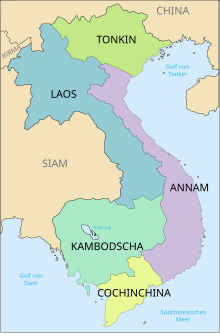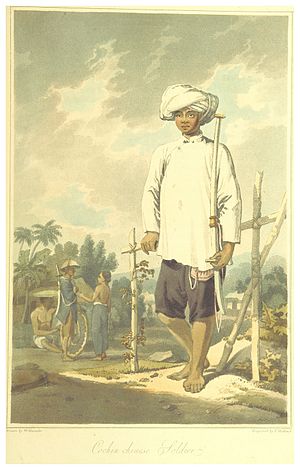Cochinchina

Cochinchina , German also Kotschinchina , French Cochinchine , Vietnamese Nam Kỳ (from Chinese南 圻, "southern border") is an old name for the south of Vietnam and parts of eastern Cambodia , between 1863 and 1954 mainly for the French colony of this name.
The term was introduced by the Portuguese Tomé Pires in 1515 as Cauchy Chyna . Pires, who was staying in Malacca at the time, took the name from Malay , where it described a country between Champa and China . The Malay term in turn came from the Chinese Jiaozhi ( Chinese 交趾 , Pinyin Jiāozhǐ , Vietnamese: Giao Chỉ), which referred to all of Vietnam including the lower reaches and delta of the Red River . China was added to distinguish the country from the Indian Cochin . However, the reverse form Chinacochim appears on Genoese maps as early as 1502/3, before the Europeans sailed the South China Sea and with it Malacca.
Later, in the 16th century, it was used to designate the separate Nguyễn state around the city of Huế , which became common European language in 1679 with the establishment of the Apostolic Vicariate of Cochinchina. From the 17th century onwards, a distinction was made between Tongking in the north and Cochinchina in the south. The southern part around Gia Định (merged with Saigon to form Ho Chi Minh City in 1979 ) and Đồng Nai was only called Lower Cochinchina in the late 18th century.
In 1862 the French annexed Cochinchina as a colonial area . The center and north became French protectorate areas under the nominal rule of the Emperor of Huế as Annam and Tongking .
After the Franco-Prussian War of 1870/71 , it was discussed whether Cochinchina should not be ceded to the German Empire as a French reparation. Reich Chancellor Bismarck rejected this.
Since the end of French colonial rule over Indochina in 1954, the name Cochinchina has been used less and less and is now out of use. The current name for the southern part of Vietnam is Nam Bộ .
The 56th Statistical Yearbook of France for the period 1940-45 gives an area of 64,700 km² (Vietnam a total of 328,000 km²). The population in 1936 was 4,616,000 (up from 18,972,000 for Vietnam as a whole).
See also
Individual evidence
- ↑ a b Li Tana: Nguyễn Cochinchina. Southern Vietnam in the Seventeenth and Eighteenth Centuries . 2nd Edition. Cornell University, 2002, ISBN 0-87727-722-2 , pp. 14 ( limited preview in Google Book search).
- ^ A b Christoforo Borri, Samuel Baron: Views of Seventeenth-Century Vietnam . Cornell University, 2006, ISBN 978-0-87727-741-5 , pp. 17–18 ( limited preview in Google Book search).
- ↑ Institut National de la Statistique et des Études Économiques: Annuaire Statistique, Cinquante-sixième volume. - 1940-45. Page 321





